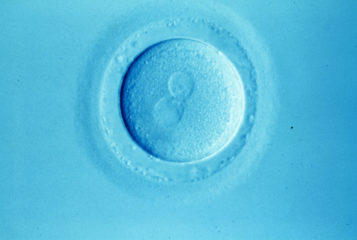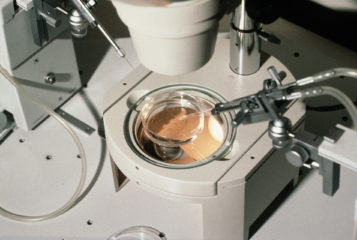Ovarian tissue freezing is offered to some young cancer patients to preserve their fertility before chemotherapy or radiotherapy. The process involves using keyhole surgery (laparoscopy) to remove all or part of an ovary. The tissue near the surface, which contains densely packed immature eggs, is thinly sliced and frozen at very low temperatures, known as cryopreservation. Years later, the tissue can be surgically regrafted in an attempt to restore fertility. In 2004, the first birth using this technique was reported (see BioNews 277) and there have been around 150 babies born worldwide since, most of which have been conceived naturally.
When ovarian tissue is successfully regrafted, ovulation resumes after weeks or months, and this is accompanied by a rise in oestrogen produced by the cells surrounding the egg. After chemotherapy, some women who experience early menopause need hormone replacement therapy (HRT), so this rise in oestrogen is a welcome benefit of the technique.
Last week, 'the first project in the world to provide healthy women ovarian tissue cryopreservation purely to delay the menopause' was announced. This service is currently only offered by ProFam, a commercial venture founded by IVF scientist Simon Fishel, but two other UK centres are said to be following suit. The media have gone to town with headlines such as 'Doctors halt the menopause' and 'the opportunity to delay menopause five, 10, 20 years…perhaps indefinitely'.
These headlines cannot be substantiated. Although the chance of ovarian tissue being successfully replaced is good, its function is limited because at least half of the stored eggs are lost during the process of freezing, thawing and regrafting. There are very few reports of grafts functioning beyond 10 years and none for 20 because the technique has not been around long enough. In fact, evidence shows that many grafts fail after one-two years (1,2), which probably relates to the volume of tissue replaced and the density of eggs, which depends on age. Thus, a whole ovary removed from a teenager undergoing serious treatment, such as bone marrow transplant for an inherited anaemia, is more likely to be successful when regrafted than if a small piece of ovary is taken from a 35-year-old.
To remove and regraft the tissue requires at least two operations, and probably more as ProFam envisage that small amounts of tissue will be replaced at intervals to prolong the effects. Surgery is also not without risk. The Royal College of Gynaecologists advises: 'The overall risk of serious complications from diagnostic laparoscopy is approximately two in 1000 women. This includes damage to the bowel, bladder, ureters, uterus or major blood vessels which would require immediate repair'. Risks are higher from operative laparoscopy. Surgery for uncertain benefit seems a drastic approach to the menopause, when good alternatives are available.
Not all women suffer problems in the menopause. Most women (80%) experience hot flushes, and other symptoms include joint and muscle stiffness, vaginal dryness and irritable bladder, low mood and anxiety, loss of libido, headaches and poor concentration (3). One in four women describe their symptoms as severe and interfering with daily life. In the long-term, lack of oestrogen increases the risk of osteoporosis and cardiovascular disease. All these effects are reversed by oestrogen, and while it is an attractive idea to 'give back your own hormones', modern hormone replacement therapy (HRT) is based on oestradiol which is bio-identical.
Physiological HRT is highly effective, simple and very safe for most women. There is no evidence to support the claims made for ovarian tissue regrafting about preventing osteoporosis and cardiovascular disease let alone depression and sexual problems. But there is scientific evidence of the benefits of HRT for all these. Moreover, HRT is very inexpensive at just a few pounds a month, compared to the cost of having laparoscopic surgery and years of cryostorage in the private sector, which has been quoted as £7000-10,000 (4).
Many women are concerned by the risks of HRT, which have been widely publicised. The most worrying is a slight increase in breast cancer with long-term (over 5 years) use. There is no data yet on breast cancer risks after tissue regrafting. However, late menopause is itself associated with breast cancer, so prolonging hormones from any source is likely to carry the same risk.
So, what is the role of ovarian tissue freezing? It has a definite place in fertility preservation where there is insufficient time, or the patient is too young for ovarian stimulation for egg/embryo freezing. However, it is not a preferred method to egg freezing. Egg and embryo freezing are well-established techniques with quantifiable success rates - certainly in the UK, where there is mandatory reporting of all treatment cycles. In contrast, we do not know the real success rate of ovarian tissue regrafting, because the published case series usually come from leading centres and there is a bias towards positive reporting in medical journalism. Moreover, the existing peer-reviewed publications focus on fertility outcomes, not hormone production.
In summary, ovarian tissue freezing is a valuable option for children and young women facing cancer treatments that will destroy fertility, but it has no proven benefit for healthy women in delaying the menopause. A media storm presenting negative messages about menopause and ageing is touching on women’s vulnerabilities, and promoting unproven claims is misleading. Until the furore dies down, health professionals and scientists should use the opportunity to provide accurate information on the potential problems of menopause and the effective solutions already available.
Declaration of interests: I lead the Fertility Preservation service and also the Menopause service at University College London Hospital. I am on the Medical Advisory Council of the British Menopause Society and I am also on the Executive Committee of the British Fertility Society. I do a small amount of private practice, in which I give the same advice to my patients as I have given in the opinions above.
Sources and References
-
3) Avis, NE et al. Duration of Menopausal Vasomotor Symptoms Over the Menopause Transition
-
1) Jensen, AK et al. Outcomes of transplantations of cryopreserved ovarian tissue to 41 women in Denmark
-
2) Kim, SS. Assessment of long term endocrine function after transplantation of frozen-thawed human ovarian tissue to the heterotopic site: 10 year longitudinal follow-up study
-
4) How to delay the menopause: can this surgery postpone “the change”?





Leave a Reply
You must be logged in to post a comment.